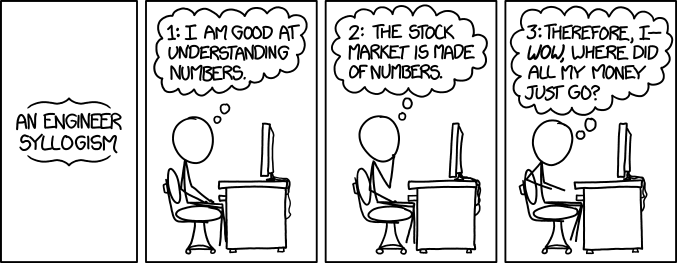
Judge Your Decisions, By Your Decisions.
At the risk of this post sounding like a book review, I

Share this post
These days, the new trader has some fantastic options available to them with regards to how they learn. There are numerous excellent simulators available that do an astonishingly good job of replicating the feel of trading in an actual live market, but without actually needing to have any money at all (other than any potential platform cost, of course). And this is great! It means you don’t have to plop down $5,000 or $10,000 just to get your feet wet, and almost surely lose it all while you make your early mistakes.
But, there comes a time in every trader’s learning curve where they need to start having some “skin in the game”. One big downside to “sim trading” is that there is no pain of loss. You can take crazy risks and if you lose, no big deal just reset and go again. It’s just a big video game! But as any trader who actually trades real money will tell you, at some point you will take losses. And if they’re too big, they can hurt. A lot!
This pain is vital to your development as a trader however, because it’s how you learn what not to do. Like a child touching something hot and realizing it hurts and yanking their hand away, vowing not to do that again. Pain teaches us things, provided we’re willing to listen to it, that is. And so everyone eventually comes to the question.
“Should I go live?”
It’s a good and valid question, the trouble is that many traders seem to think there will be some “a-ha” moment, the angels will sing, the clouds will part, the sun will beam its glorious rays onto you and you will know, nay, you will feel, that you are definitely ready for real money. The truth is a lot more mundane though. It’s likely to be a lot less clear and you might go back & forth quite a few times on if you should or if you shouldn’t. I’d say this is natural, as you come to grips with the reality that your money could all just disappear in a flash if you aren’t sure of what you’re doing. Or really, even if you are!

Fortunately there is actually a middle-ground these days. Trading Evaluators (AKA “Trading Combines” after the American Football term) are companies who, for a modest fee, will give you a dedicated sim account where they require you to follow certain rules/limitations. If you are able to pass the combine (usually meaning reach some revenue target without breaking any of their rules), they will give you a small account of live money from investors, and you get to trade it. This way you have a small financial commitment (usually around $100/month or so but varies up or down depending on the account size you want) and therefore a little bit of financial pain in the form of a fixed cost, but a great deal of potential upside if you can pass.
Sounds like a dream come true doesn’t it? Welllllll… not so fast. These companies use rules that are quite strict, and sometimes confusing. I would even say there is an argument to be made, that some rules are intentionally designed to trip you up and increase the chances you fail. They will of course allow you to “reset” your account as many times as you want – for a fee, of course (usually about $150 each time). Needless to say, these fees add up quickly and most traders never manage to pass. But if you have the self control, the discipline, a genuine statistical edge in your trading, then you just might manage to earn a “funded account” from one of these companies, and begin sharing in a majority share of the profits you make with their money.
Still however, I think most traders eventually want to trade their own money. That’s the big dream isn’t it? To answer to no one, set your own hours, be your own boss, and keep 100% of the profits for yourself. Unfortunately you also have to eat 100% of the losses, and pay 100% of the costs, too! But for those who can handle the psychological switch to trading their own hard-earned money, the potential rewards are mighty sweet indeed.
OK so let’s imagine the day has come where you’ve decided, this is it. Today’s the day. You have an account. You’ve put maybe $5,000 in, Or maybe it’s more, maybe it’s less, it doesn’t really matter. The point is, you’re ready to rock! But are you really? Do you know what market(s) you’re going to trade? Do you understand the leverage that might exist in them? Do you know the rules around “Pattern Day Trading” and “Wash Sales” and how you could get into enormous trouble if you trade the wrong things in the wrong way? There’s a lot of potential land mines you’ll need to watch out for, and any one of them can pretty quickly blow up your account if you aren’t careful.
Fortunately again, we have some fantastic new things that have just come into existence in the last couple of years, that are perfect for the beginning trader. In specific I’m talking about Micro Futures Contracts. These are simply perfect for the trader who is just deciding to go live and wants to feel what that’s like, with a much, much lower risk exposure than if they were trading “regular” futures contracts. I can’t go into all the specifics of what micros are, what futures are, how to trade them, and all that stuff here… but I suggest you start with the CME website for general futures information and if you want some first-class training in how to trade them, check out our upcoming classes.
The short version is that micro futures are 1/10 the value of “normal” futures. This means everything is smaller, gains and losses. Since the odds are you’re going to suffer some losses while you first get comfortable with trading real money, you would be wise to keep those losses as small as you possibly can. Because as you will no doubt discover, trading real money is not the same as trading in a sim, or even a combine. Psychologically, we all tend to have issues surrounding money. Greed, FOMO (Fear Of Missing Out), fear of loss, even fear of gains! Trading will bring absolutely every one of your psychological money-related weaknesses front & center, and you will have no choice but to confront them head-on. It’s a whole lot easier to do that when your account equity is swinging up or down $5 or $50 at any given moment, than if it’s swinging by $500 or $5,000!
So in closing, a general rough sense I’ve used for myself and something I’ve suggested to other traders I’ve known, is that if the question is being asked then it’s probably time. You will learn a tremendous amount about yourself both as a trader and as a person, by going live. You’ll have emotional highs and lows, but never forget that this is a survival game. You win by not losing. Trade small, stick to your process, execute against your legitimate edge, and let the probabilities take care of themselves.
Until next time, trade well!
Jonathan van Clute
Community Manager, Trading Research Group
Share this post
You Might Also Be Interested In:

At the risk of this post sounding like a book review, I

As I write this, it’s mere hours away from the clock striking

Well seeing as how it’s “the day after Black Friday” in the

There is a risk of loss in futures, forex and options trading. There is risk of loss trading futures, forex and options online. Please trade with capital you can afford to lose. Past performance is not necessarily indicative of future results. Nothing in this site is intended to be a recommendation to buy or sell any futures or options market. All information has been obtained from sources, which are believed to be reliable, but accuracy and thoroughness cannot be guaranteed. Readers are solely responsible for how they use the information and for their results. Trading Research Group does not guarantee the accuracy or completeness of the information or any analysis based thereon.
Hypothetical performance results have many inherent limitations, some of which are described below. No representation is being made that any account will or is likely to achieve profits or losses similar to those shown; in fact, there are frequently sharp differences between hypothetical performance results and the actual results subsequently achieved by any particular trading program. One of the limitations of hypothetical performance results is that they are generally prepared with the benefit of hindsight. In addition, hypothetical trading does not involve financial risk, and no hypothetical trading record can completely account for the impact of financial risk of actual trading. for example, the ability to withstand losses or to adhere to a particular trading program in spite of trading losses are material points which can also adversely affect actual trading results. There are numerous other factors related to the markets in general or to the implementation of any specific trading program which cannot be fully accounted for in the preparation of hypothetical performance results and all which can adversely affect trading results.
This presentation is for educational purposes only and the opinions expressed are those of the presenter only. All trades presented should be considered hypothetical and should not be expected to be replicated in a live trading account.
Testimonials and reviews appearing on this website may not be representative of other clients or customers and is not a guarantee of future performance or success.
© 2022 Make Ticks LLC dba Trading Research Group. All rights reserved. TickMaker™ is a trademark of Make Ticks LLC.